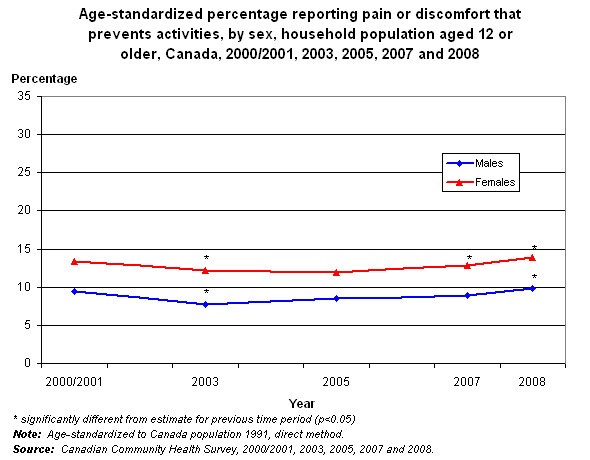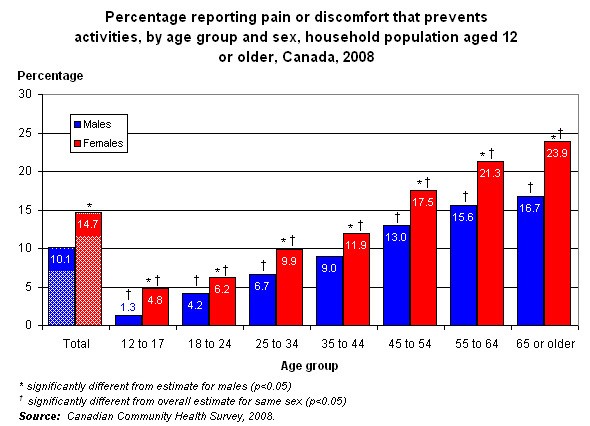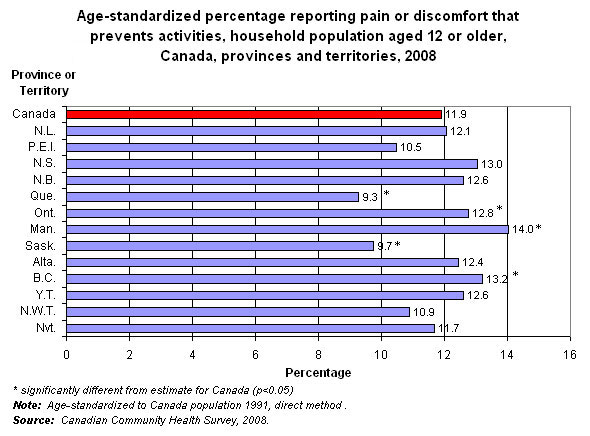Publications
Healthy people, healthy places
+Demographic change
+Health status
+Health behaviours
+Environment
Pain or discomfort that prevents activities
Archived Content
Information identified as archived is provided for reference, research or recordkeeping purposes. It is not subject to the Government of Canada Web Standards and has not been altered or updated since it was archived. Please "contact us" to request a format other than those available.
The presence of pain was measured as the population aged 12 or older who reported having pain or discomfort that prevents a few, some or most activities versus none.
Importance of indicator
The importance of pain as a public health issue lies in its high prevalence and impact. More than providing an estimate of how many people are experiencing pain, this indicator captures the percentage of the population who some degree of functional limitation associated with that pain.
Background
Studies of chronic pain in Canada have found that it is a commonly reported condition. Among people living in private households, 16% of those aged 18 to 64 and 27% of seniors reported chronic pain. The prevalence rose to 38% for seniors living in long-term health care institutions1.
Women are more likely to report chronic pain than men, older people more than younger people2,3,4.
Individuals with low educational attainment are more likely to report chronic pain than those with higher levels of education4.
Chronic pain is associated with dependency in activities of daily living (for example personal care, moving around the home) and instrumental activities of daily living (for example errands, housework)5.
The more severe the pain, the more likely it is to interfere with a person's daily activities. And the presence or absence of chronic pain is associated with people's happiness and perceived health4,6,7.
People reporting chronic pain are more likely to use medications and be multiple medication users1.
Highlights and graphs
Time trend

- From 2000/2001 to 2008, the age-standardized percentage of Canadians reporting pain or discomfort that prevented activities remained relatively stable.
- Year-to-year fluctuations were relatively small; the age-standardized percentage dipped slightly in 2003, but increased again by 2008.
- Females were consistently more likely than males to report pain or discomfort that prevents activities.
Note: Age–standardized, direct method to 1991 Canada population.
Age group and sex

- In 2008, an estimated 10% of males (1.4 million) and 15% of females (more than 2 million) aged 12 or older reported pain or discomfort that prevents activities.
- Parallelling the increasing prevalence of chronic conditions and activity limitations with advancing age, the percentage of Canadians reporting pain and discomfort that prevent activities rose with age—by age 65 or older, this was the case for 17% of males and 24% of females.
- In all age groups, females were more likely than males to report pain and discomfort that prevents activities.
Province

- Residents of Quebec and Saskatchewan were less likely to report pain and discomfort that prevents activities, compared with Canadians overall. In Ontario, Manitoba and British Columbia, prevalence was higher than the national figure.
- In Nova Scotia, the crude estimate of pain and discomfort that prevents activities exceeded that for Canada overall. However, the estimate lost statistical significance when the age structure of the province was taken into account.
- For Nunavut, the estimate was lower than for Canada until the age structure of the territory was taken into account. This indicates that Nunavut's lower prevalence of pain and discomfort that prevent activities is influenced by the high percentage of young people, who are less likely than older people to experience pain and discomfort.
Note: Age–standardized, direct method to 1991 Canada population.
References
1. Ramage-Morin P. Medication use among senior Canadians. Health Reports (Statistics Canada, Catalogue 82-003) 2009; 20(1):37-44.
2. Statistics Canada. Women in Canada : a gender-based statistical report, 5th ed. (Statistics Canada, Catalogue 89-503) March 2006.
3. Bizier V, Chong P, Foisy M, et al. Participation and Activity Limitation Survey 2006: Analytical Report (Statistics Canada, Catalogue 89-628) December 2007.
4. Ramage-Morin P. Chronic pain in Canadian seniors. Health Reports (Statistics Canada, Catalogue 82-003) 2008;19(1):37-52.
5. Gilmour H, Park J. Dependency, chronic conditions and pain in seniors. Health Reports (Statistics Canada, Catalogue 82-003) 2006;(suppl):21-31.
6. Shields M, Shooshtari S. Determinants of self-perceived health. Health Reports (Statistics Canada, Catalogue 82-003) 2001;13(1):35-52.
7. Ramage-Morin P. Successful aging in health care institutions. Health Reports (Statistics Canada, Catalogue 82-003) 2005;16 (suppl.):47-56.
- Date modified:
